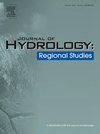Machine learning projections of Iran’s water scarcity response to climate-land use synergies
IF 4.7
2区 地球科学
Q1 WATER RESOURCES
引用次数: 0
Abstract
Study region
Iran faces severe water stress with over 88 million people and 14.2 million hectares of cultivated land. Agriculture consumes over 87 % of national water, with total withdrawals exceeding 80 % of renewable resources. From 2003–2019, total water storage declined by over 200 BCM, exceeding annual national consumption.
Study focus
This study analyzed the impacts of climate change and cultivated area on Iran’s total water storage. Country-wide actual evapotranspiration (ETa) in agricultural and non-agricultural sectors was simulated using machine learning and statistical analysis. Changes in total water storage were then projected via the water balance equation using bootstrap sampling, under combined climate change and cultivated area management scenarios.
New hydrological insights
Projections indicate that by 2100, climate change will increase nationwide ETa by up to 7.7 % and agricultural ETa by 23.8 %. Even 10 % reduction in cultivated area cannot offset the impacts of changing climate. Under high emissions scenarios, nationwide ETa will increase by 37.1 BCM (21 %) and agricultural ETa by 17.5 BCM (39 %) compared to the 2009–2014 baseline. Given current consumption trends and high withdrawal ratios (>80 %), aquifer deficits are projected to increase by 300 BCM (42 %) to 578 BCM (174 %) over the next two decades, depending on climate scenarios. These findings warn that failure to manage demand and improve irrigation efficiency in agriculture will seriously threaten the country’s water and food security.
机器学习预测伊朗水资源短缺对气候-土地利用协同效应的响应
伊朗有超过8800万人口和1420万公顷的耕地,面临严重的水资源压力。农业用水占全国总用水量的87% %以上,可再生资源的总取水量超过80% %。从2003年到2019年,总储水量减少了200多亿立方米,超过了全国年消费量。本研究分析了气候变化和耕地面积对伊朗总储水量的影响。利用机器学习和统计分析模拟了全国农业和非农业部门的实际蒸散量(ETa)。在气候变化和耕地管理相结合的情景下,利用自举抽样方法,通过水量平衡方程预测了总储水量的变化。新的水文洞察预测表明,到2100年,气候变化将使全国ETa增加7.7% %,农业ETa增加23.8% %。即使耕地面积减少10% %也无法抵消气候变化的影响。在高排放情景下,与2009-2014年基线相比,全国ETa将增加371亿立方米(21. %),农业ETa将增加17.5亿立方米(39. %)。考虑到目前的消费趋势和高取水率(> 80% %),根据不同的气候情景,未来20年含水层亏缺预计将增加300亿立方米(42 %)至578亿立方米(174 %)。这些发现警告说,如果不能管理需求和提高农业灌溉效率,将严重威胁到该国的水和粮食安全。
本文章由计算机程序翻译,如有差异,请以英文原文为准。
求助全文
约1分钟内获得全文
求助全文
来源期刊

Journal of Hydrology-Regional Studies
Earth and Planetary Sciences-Earth and Planetary Sciences (miscellaneous)
CiteScore
6.70
自引率
8.50%
发文量
284
审稿时长
60 days
期刊介绍:
Journal of Hydrology: Regional Studies publishes original research papers enhancing the science of hydrology and aiming at region-specific problems, past and future conditions, analysis, review and solutions. The journal particularly welcomes research papers that deliver new insights into region-specific hydrological processes and responses to changing conditions, as well as contributions that incorporate interdisciplinarity and translational science.
 求助内容:
求助内容: 应助结果提醒方式:
应助结果提醒方式:


